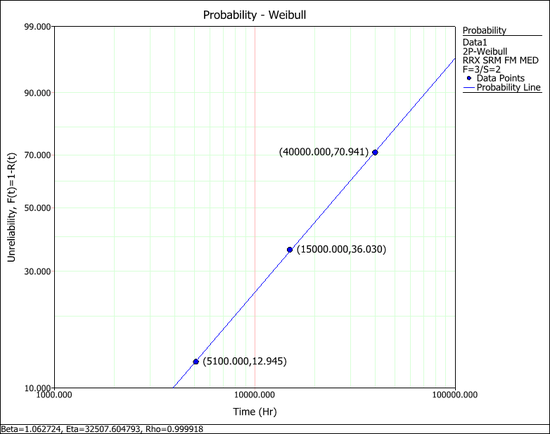Median Rank for Multiple Censored Data: Difference between revisions
Jump to navigation
Jump to search
Kate Racaza (talk | contribs) No edit summary |
Kate Racaza (talk | contribs) No edit summary |
||
| (3 intermediate revisions by the same user not shown) | |||
| Line 1: | Line 1: | ||
{{Reference Example}} | {{Reference Example}} | ||
This example | This example validates the median rank calculation for multiple censored data in Weibull++ standard folios. | ||
{{Reference Example Heading1}} | {{Reference Example Heading1}} | ||
Table 3.1 on page 78 in book | Table 3.1 on page 78 in the book ''Reliability & Life Testing Handbook Vol 2'' by Dr. Kececioglu, Prentice-Hall, 1994. | ||
| Line 53: | Line 53: | ||
The differences between the results in Weibull++ and the book are due to the method of calculating the median ranks (MR). In the book, the following approximation method is used | The differences between the results in Weibull++ and the book are due to the method of calculating the median ranks (MR). In the book, the following approximation method is used: | ||
::<math>MR_{i}\approx \frac{MON_{i}-0.3}{N+0.4}</math> | ::<math>MR_{i}\approx \frac{MON_{i}-0.3}{N+0.4}</math> | ||
| Line 61: | Line 61: | ||
In Weibull++, the following exact method is used | In Weibull++, the following exact method is used: | ||
::<math>MR_{i}= \frac{1}{1+\frac{N-MON_{i}+1}{MON_{i}}F_{0.5,m,n}}</math> | ::<math>MR_{i}= \frac{1}{1+\frac{N-MON_{i}+1}{MON_{i}}F_{0.5,m,n}}</math> | ||
where <math>m=2(N-MON_{i}+1), n= | where <math>m=2(N-MON_{i}+1), n=2\times MON_{i}\cdot F_{0.5,m,n}\,\!</math> is the 50 percentile of a F distribution with degree of freedom of ''m'' and ''n''. | ||
Latest revision as of 16:20, 28 September 2015
New format available! This reference is now available in a new format that offers faster page load, improved display for calculations and images and more targeted search.
As of January 2024, this Reliawiki page will not continue to be updated. Please update all links and bookmarks to the latest references at Weibull examples and Weibull reference examples.

